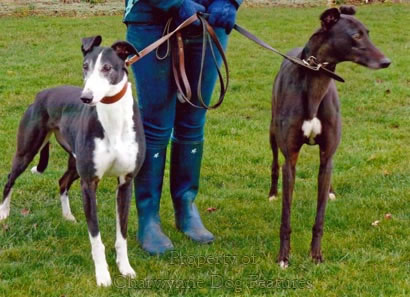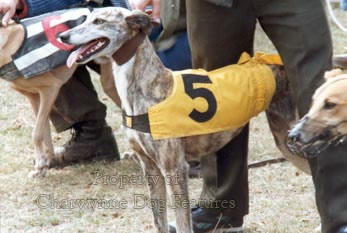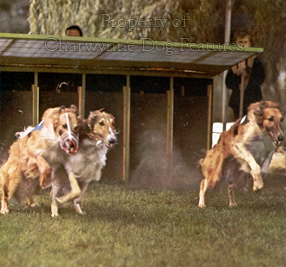4 PRESERVING WORKING SKILLS
PRESERVING WORKING DOG SKILLS - SIGHTHOUNDS
by David Hancock
 Preserving Sighthound Skills
Preserving Sighthound Skills
We are now faced with an unprecedented challenge to our sighthounds, the law of the land is against the function for which they were bred and used for over several thousand years. When a highly-regulated field sport becomes proscribed, unregulated illegal hunting, with no respect for the quarry, replaces it. This will be a disaster for our wildlife and a major setback not just for sighthounds but for the quarry species too. But in the time it takes to realise legislative folly and then restore sanity to the scene, what can we do to preserve the sighthound skills? Track racing, lure-chasing and hound matches need to be supported; these superlative hounds need to be tested, if only to identify the best breeding stock. (Despite being classified as a Toy breed, even the Italian Greyhound needs to sprint!) We need the same dedication that developed their amazing talents now to be devoted to their preservation, and not just for their sakes, but that of their quarry too.
Sporting Salvation
As with a number of scenthound breeds, the future of the sighthound breeds is worryingly uncertain. Greyhounds have their racing side, Whippets have their admirable working Whippet club, lurchers have both a national body and a racing organisation, Afghan Hounds have their racing set-up – with other breeds encouraged to go along too but the loss of the coursing clubs leaves a big hole. No one body is caring for the sporting future of the sighthound. The kennel clubs of the world are not established to do this and could end up being the ‘Avon Ladies’ of the dog world, concerned only with cosmetic appeal, more focussed on presentation than performance. Their inability to understand the origins of the sighthound breeds illustrates their lack of real appreciation. In just one national kennel club’s official publication, the Ibizan Hound’s history is ‘traceable back to approximately 3400BC, with the glory that was ancient Egypt the most fitting setting for this regal hound, which was owned and hunted by the Pharaohs’; the Pharaoh Hound is ‘considered one of the oldest domesticated dogs in recorded history, tracing his lineage to roughly 3000BC. Fortunately, the history of Egyptian civilization was well documented and preserved through paintings and hieroglyphics and from these we learn that this unique dog…’ and the Saluki is described as ‘The Royal Dog of Egypt…a distinct breed and type as long ago as 329BC when Alexander the Great invaded India.’ What do they think went before? How can they ignore the Sumerians and not mention the Hyksos? The ancient Egyptians may have had the artefacts but the steppe nomads had the dogs! I shudder to think how they would have covered, say, a discovery of carvings at Stonehenge of dogs like the bat-eared purely British-blooded lurchers illustrated here! Sporting dogs, sighthounds especially, whatever their provenance, are easily lost to us once their founding function is removed; the survival of pedigree breeds by itself is only half the answer. 
Breed Care
I believe that it is entirely fair to state that most breed clubs exist to serve the exhibition side of the breed’s affairs. But to care comprehensively for a breed, especially a sporting one and a sighthound one in particular, there is a distinct need for each breed club to feature: an archivist – who really must know the difference between a Tesem and a Tasy; a health watch scheme – which at long last the Kennel Club is urging; a proactive rescue system; a consultant morphologist – who really knows what the breed should look like and is guided by the KC’s commendable ‘fit-for-function’ campaign; and last but far from least, a sporting wing, running lure-racing, speed-racing – rather as the admirable Afghan Hound people do and any other physical activity for these remarkable hounds. From such a structure would come a renewed appreciation of what these dogs are for, where they came from, what they should look like and how to promote their well-being. These breeds must be conserved as hunting dogs.
Unwise Policy
In his book Medieval Hunting, Sutton Publishing Ltd., 2003, Richard Almond writes: “Man needs to hunt to release the pressures of being human, to appreciate the countryside, the seasons, to be aware of the beauty and brevity of life, and the inevitability and sadness of death…We are the inheritors of hunter-gatherers from not so long ago and the streams of consciousness of our ancient ancestors still runs deep and powerful.” When the next sizeable meteorite hits Mother Earth, as it surely will, who will be more likely to survive, the simple hunter with his efficient hunting dogs or a city dwelling merchant banker? When a distinguished diplomat and Saluki breeder is prevented from importing desert Salukis from the sheikhs by our Kennel Club because their pure breeding is in question we have clearly lost our way. When Bloodhound fanciers object to hounds from the packs being registered as Bloodhounds with the KC because their pure breeding is disputed, we have, in the modern idiom, lost the plot. 
Community Event
It is so often overlooked by scholars that hunting in medieval times was very much a community event; the tenantry and those living in the countryside all took part in the chase. The poet Wordsworth picked this up in his words:
“Up, Timothy, up with your staff and away!
Not a soul in the village this morning will stay;
The hare has just started from Hamilton’s grounds,
And Skiddaw is glad with the cry of the hounds.”
There has long been a democratic basis to the hunting field that overcomes the different levels of class and social position, valuing instead capability and prowess. Hunting in the Middle Ages was much more inclusive, embracing every stratum of society and filling a larger social need than some historians will admit. As Henry Savage pointed out in his contribution to Speculum in 1933: “The hound of the middle ages was for use. It would have been strange for the medieval ‘venator’ to have thought of wolf-hounds without thinking of wolves, of deerhounds without thinking of deer. Our fathers protected the game to hunt it; we do not protect it, and are reduced to the necessity of pursuing anise-seed bags! If we are coming to a realization of the importance of conservation, we are only finding out what our fathers knew.” Moral vanity and the dislike of the chase by academics often ignores not just social history but what courses through our primaeval veins.
Loss of Working Anatomy
The handlers of sighthounds at Crufts are unlikely to know of the medieval ‘fewterers’ who held the sighthounds in the chase or the criteria they worked to. The hound judges at Crufts in 2008 made these comments on the hounds before them: Afghan Hounds; '...the breed has been getting further away from its origins and although there are many glamorous coated hounds there are fewer and fewer that display the true essence of the breed...' and ‘...he is a hunting hound not a dressed up puppet'. Borzoi; 'The Borzoi has to be able to chase and hold down a large formidable animal, could yours?' Pharaoh Hounds; 'This is a running hound and I was disappointed to find only a handful of dogs who were well muscled and fit...' What were those like which didn't qualify for Crufts! It is foolish to leave a sighthound breed entirely in the hands of its show ring fraternity. Most of the latter would welcome the involvement of and advice from those who use their hounds. The future of these outstanding hounds is threatened as never before; it will take both vision and dedication to retain them as true sporting hounds still able to carry out their historic role. I trust this book will contribute to securing their sporting future.
“In the world of dogs the sighthounds certainly constitute the most striking illustration of the adage ‘Beauty is born of the adaptation to function’. Today most are no longer utilized hunting by sight, a type of hunt forbidden almost everywhere or supplanted by the gun.”
Chiens de France No 9, 1994.
“Greyhounds love to run. Anyone who has spent any time around them knows that to be true. There is no need to prod, urge – or – God forbid – whip Greyhounds into action. Running is what Greyhounds were created for – both psychologically and physiologically. Greyhounds need to run as much as other breeds may need to herd or retrieve.”
The Reign of the Greyhound by Cynthia A Branigan, Howell House Books, 2004.